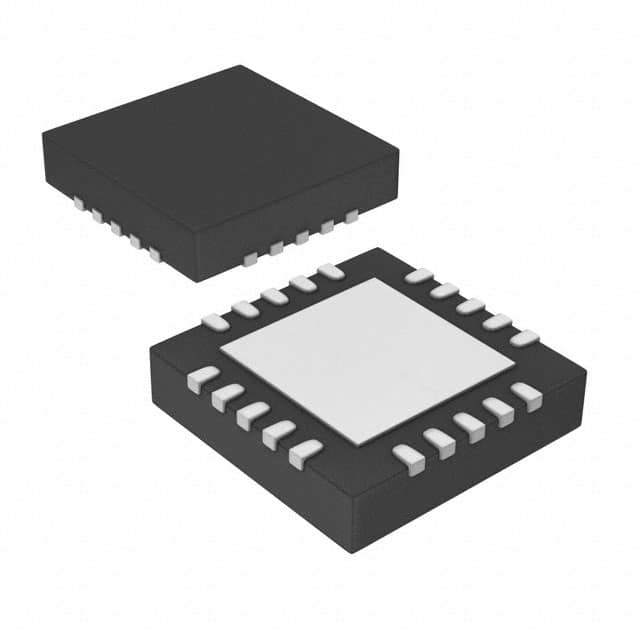Consulte las especificaciones para obtener detalles del producto.

PIC16F1619-I/ML
Product Overview
Category
The PIC16F1619-I/ML belongs to the category of microcontrollers.
Use
This microcontroller is commonly used in various electronic applications that require embedded control and processing capabilities.
Characteristics
- High-performance 8-bit RISC architecture
- Flash program memory with self-read/write capability
- Enhanced mid-range core with 49 instructions
- Wide operating voltage range: 1.8V to 5.5V
- Low power consumption
- Multiple communication interfaces (UART, SPI, I2C)
- Analog-to-Digital Converter (ADC) for sensor interfacing
- Timers and PWM modules for precise timing and control
- Integrated EEPROM for non-volatile data storage
Package
The PIC16F1619-I/ML is available in a small form factor package known as QFN-28.
Essence
The essence of this microcontroller lies in its ability to provide a compact and versatile solution for embedded control applications.
Packaging/Quantity
The PIC16F1619-I/ML is typically packaged in reels containing 250 units per reel.
Specifications
- CPU Speed: Up to 32 MHz
- Program Memory Size: 14 KB
- RAM Size: 1 KB
- Number of I/O Pins: 25
- Operating Temperature Range: -40°C to +125°C
- Supply Voltage Range: 1.8V to 5.5V
- Data EEPROM Size: 256 bytes
- ADC Resolution: 10-bit
- Communication Interfaces: UART, SPI, I2C
- Timers: 3 x 8-bit, 1 x 16-bit
- PWM Modules: 2
- Oscillator Options: Internal, External, or Crystal
Detailed Pin Configuration
The PIC16F1619-I/ML microcontroller has a total of 28 pins. The pin configuration is as follows:
- RA0 - Analog Input / Digital I/O
- RA1 - Analog Input / Digital I/O
- RA2 - Analog Input / Digital I/O
- RA3 - Analog Input / Digital I/O
- RA4 - Digital I/O
- RA5 - Digital I/O
- VSS - Ground
- MCLR/VPP - Master Clear / Programming Voltage
- VDD - Power Supply
- RC0 - Digital I/O
- RC1 - Digital I/O
- RC2 - Digital I/O
- RC3 - Digital I/O
- RC4 - Digital I/O
- RC5 - Digital I/O
- VSS - Ground
- OSC1/CLKIN - Oscillator Input
- OSC2/CLKOUT - Oscillator Output
- RC6 - Digital I/O
- RC7 - Digital I/O
- RB0 - Digital I/O
- RB1 - Digital I/O
- RB2 - Digital I/O
- RB3 - Digital I/O
- RB4 - Digital I/O
- RB5 - Digital I/O
- VSS - Ground
- RB7 - Digital I/O
Functional Features
The PIC16F1619-I/ML microcontroller offers the following functional features:
- High-performance RISC architecture for efficient execution of instructions.
- Flash program memory with self-read/write capability, allowing for easy firmware updates.
- Enhanced mid-range core with a wide range of instructions for versatile programming.
- Multiple communication interfaces (UART, SPI, I2C) for seamless integration with other devices.
- Analog-to-Digital Converter (ADC) for precise measurement and interfacing with sensors.
- Timers and PWM modules for accurate timing and control of external devices.
- Integrated EEPROM for non-volatile data storage, ensuring data retention even during power loss.
Advantages and Disadvantages
Advantages
- Compact size and low power consumption make it suitable for portable and battery-powered applications.
- Wide operating voltage range allows for flexibility in different power supply scenarios.
- Versatile communication interfaces enable easy integration with other devices.
- Rich set of peripherals (ADC, timers, PWM) provide enhanced functionality.
- Flash program memory allows for easy firmware updates and customization.
Disadvantages
- Limited program memory size may restrict the complexity of applications.
- Limited RAM size may impose constraints on data storage and processing capabilities.
- Lack of built-in hardware encryption or security features may require additional measures for secure applications.
Working Principles
The PIC16F1619-I/ML microcontroller operates based on the principles of a RISC architecture. It executes instructions stored in its flash program memory to perform various tasks. The core of the microcontroller is designed to efficiently execute instructions, enabling
Enumere 10 preguntas y respuestas comunes relacionadas con la aplicación de PIC16F1619-I/ML en soluciones técnicas
What is the maximum operating frequency of PIC16F1619-I/ML?
- The maximum operating frequency of PIC16F1619-I/ML is 32 MHz.Can PIC16F1619-I/ML be used for motor control applications?
- Yes, PIC16F1619-I/ML can be used for motor control applications with its integrated peripherals and PWM capabilities.Does PIC16F1619-I/ML support communication protocols like I2C and SPI?
- Yes, PIC16F1619-I/ML supports communication protocols such as I2C and SPI.What are the available memory options for program storage in PIC16F1619-I/ML?
- PIC16F1619-I/ML offers flash program memory options ranging from 3.5 to 14 KB.Can PIC16F1619-I/ML be used in battery-powered applications?
- Yes, PIC16F1619-I/ML is suitable for battery-powered applications due to its low power consumption features.Are there any development tools available for programming PIC16F1619-I/ML?
- Yes, there are various development tools and IDEs available for programming and debugging PIC16F1619-I/ML.What are the analog-to-digital converter (ADC) specifications of PIC16F1619-I/ML?
- PIC16F1619-I/ML features a 10-bit ADC with up to 24 channels for analog input.Can PIC16F1619-I/ML be used in automotive applications?
- Yes, PIC16F1619-I/ML is suitable for automotive applications with its robust design and temperature range.Does PIC16F1619-I/ML have built-in security features?
- Yes, PIC16F1619-I/ML offers various security features to protect the code and data.What are the available package options for PIC16F1619-I/ML?
- PIC16F1619-I/ML is available in various package options including QFN, UQFN, and DIP.

